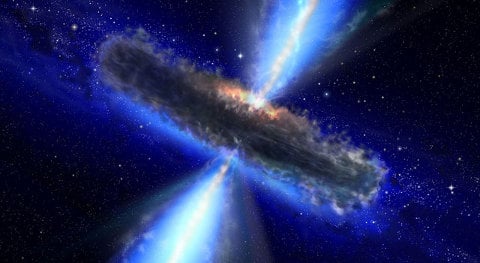This article is more than 1 year old
Mega-colossal space raincloud found at moist black hole
Soggy quasar's eternal downpour worse than Brit summer
A cloud of water vapour surrounding a quasar 12 billion light-years away has been spotted by two independent research groups, putting a huge mass of water in the very early universe.
Two teams of sky-watching boffins spotted the cloud, confirming expectations that water existed very early in the universal life cycle. Until now, water hadn't been seen nearly so far away (and thus long ago). The quasar concerned delights in the catchy moniker of "APM 08279+5255", and is apparently putting out enough heat, and x-rays, to keep the surrounding cloud at a relatively-balmy -53°C.
At that light density (300 trillion times less dense than the Earth's atmosphere, we're told) that's enough to keep the water vaporous, rather than locked in lumps of ice like the stuff we find more locally.

Just in case you're wondering what a quasar looks like: full image and details from NASA
The cloud is huge, containing 140 trillion times the volume of our oceans, but that's impossible to envision, so let's just say it's really big. It is also gently falling into a black hole which keeps the quasar going and will do for the foreseeable future.
The cloud was spotted, almost simultaneously, by two teams of researchers: one led by Matt Bradford, of NASA's Jet Propulsion Laboratory, and the other by Dariusz Lis, senior research associate in physics at Caltech.
Both teams detected the water from spectral analysis, with the JPL team getting enough readings to estimate the size of the cloud.
How long it will take for the cloud to be entirely consumed the researchers don't know; apparently there's a good chance some of it will coalesce into a star or two before it gets eaten (it's a really big cloud), while other parts may be pushed away. ®
